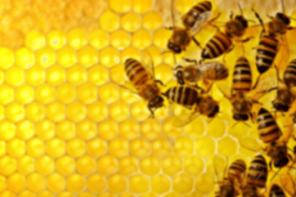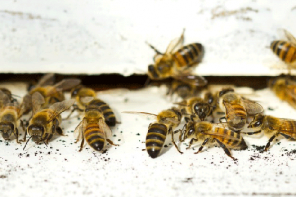Numbers. I didn’t major in math in college. Not even close. I took the requisite classes – algebra, calc, stats (or stix, or statistics) but that’s about it. I actually took calc and organic chemistry during a Summer session while working full time for the city of Madison as a landscaper. It was three months of absolutely no sleep). Anyway, I like statistics more than any of them because those numbers actually can be used for things I do on a daily basis. The monthly honey report for instance.
So when I run into articles that talk about numbers, I’m usually curious – curious to see what they are talking about, and even more curious to see if they got the numbers right.
This is the background for the rest of this…
Newspapers and magazines. How many do you get every day, week, month? I’m a news junkie, so I probably get more than most. A quick review of the stack next to my chair shows four weekly newspapers, two daily newspapers, five weekly magazines (all news sources), four monthly farming magazines, and a few (several, many, some – take your pick) others from various sources about various topics. Next to that pile is the pile of beekeeping magazines that come to the office routinely – I can count 21 different sources from where I’m sitting right now. There’s more but I can’t see the covers from here.
Well, the world of paper is changing, as you well know. Digital sources of news – the headline only type – have made an impact on what people read and where they read it. And that has made an impact on what’s produced on paper. Newspaper employment has dropped by 60% since 1990, and 2016 had the lowest daily newspaper circulation since 1940. A third of all the newspapers in the US have changed hands since 2004 (for instance, the Monterey Herald, in CA, owns just over 60 other newspapers including the Denver paper – what does Monterey know about Denver?), with many of them a part of some consolidation or other. And try and find someone to deliver those papers to the mud puddle on the side of your driveway anymore. That, and the fact that almost all national papers now contract with local papers for delivery, and when one is late, all are late (I used to get three daily papers, all delivered in the same plastic bag). Plus, just over 600 newspapers have closed in the U.S. since 2004, and newspaper ad revenue has declined by 63% in just the last 10 years.
Speaking of ad revenue, for magazines it’s in the pits. In 1990 magazines spent about $42 per person in the U.S., it reached its peak between 2000 and 2008 at about $65 per person, and last year it was at its lowest in nearly 30 years at $22 per person. This is mostly for general interest mags. Us niche players are still doing OK. All this from the Post Office, don’t you know.
And there’s good reason for all this of course. Newspapers (daily, weekly combined) per household per week in 1987 were at 0.6, now down to 0.1. Magazines of all kinds per household per week in 1987 were at 1.0 (every house in the US got some kind of magazine every week), but last year, it’s down to 0.5 per week (only half). Monthly magazines, which this happens to be, have gone from 0.6 per household per week in 1987 down to 0.4 per week. Not quite as bad, but still . . .
What’s keeping these operations going, of course, is that trend toward digital. If you can’t beat ‘em, join ‘em, and we’ve joined ‘em hands down. More people read our paper issue than subscribe to our digital issue, but more people by way, way far read our web page than the digital, paper and app combined. That’s true almost everywhere.
And what’s keeping the digital important is the credibility of their paper parents. We all know the warnings given to us in beginning beekeeping classes about what you can find on the internet. Those YouTube videos, blogs and whatnots by who-ever simply don’t have the credibility of the old time, well known sources of information. Subscribe to a magazine is the statement of record in those classes, or at least go to their webpage.
But still, most folks, except for those of us relaxing in that chair like mine in the living room, get their stuff on the web, and growing steadily, on our phones. Yes, there’s a hard core bunch that still like the feel and smell of a paper magazine or newspaper, or the weight of a book on our lap, but we are slowly becoming dinosaurs, page by page.
More numbers.
One of the things I’ve been wondering about has been the news about the people at our southern border. For those who are here with H-2B Worker Certifications, what work are they doing? Specifically, how many are working in beekeeping operations. So here’s some more numbers.
Landscaping/ groundkeeping/forestry – 64,800; Maids/restaurant/cooks/food concession – 18,200; Meat cutters – 7,000; Construction – 4.500; Amusement attendants –7,100; non-farm animal caretakers – 1,600. This last category doesn’t include beekeepers. They aren’t on any list I could find.
Numbers.
Podcasts.
When you want to hire a H-2B employee, you submit an application and your request goes into a lottery. You might get to hire one of the 66,000 people that fit this category now, and you might not. It used to be that if a person came here previously, they wouldn’t fall under the new ceiling of 66,000 H2-B visas per year. That’s now the ceiling for all H2-B visas. One wonders where the other 37,200 jobs will be, who will fill them, and do any of these people know how to keep bees? With unemployment heading toward zero, there are no extra hands to help, anywhere.
Even more numbers.
Did you take a look at the honey report this month? We looked at what our reporters think is important in their businesses. Labels, size of jars, where they sell, what else is on the jar, price and all the rest. I have to admit, that price wasn’t at the top of the list is encouraging. People are buying honey because they want the honey and price doesn’t scare them away. And our prices aren’t Walmart basement prices by any stretch. Our reporters, for the most part sell all or at least some of their honey at full retail. Some in barrels, yes, but lots is retail. I trust that will continue. Or at least hope it will.
•
Enough numbers.
Have you had the opportunity to listen to our recently introduced podcast called Beekeeping Today-Podcast? You can find it at www.beekeepingtodaypodcast.com. There are several beekeeping podcasts out there and I’ve listened to a few of them. These are different. We don’t have a point to prove, or a stance to defend, a widget to sell, or a way of life to share.
If you haven’t listened to a podcast by anybody yet you can click on any of those listed on the web page and sit back and listen at your computer. Or, you can download one of several apps listed on the page to your smart phone and listen from there, with or without a headset. Or, you can send it to another device or a friend to listen to also. It’s simply audio, nothing to watch, so if you have the phone/radio hook-up in your car you can listen while driving.
What we do is, talk to people. The first few we did were posted during Pollinator week in June, so we talked to four people in the world of pollinators. John Miller of Miller Honey, (and of My Story coming this October) and Joe Traynor, an almond pollination broker in Bakers-field, CA covered the industrial side of commercial pollination, while Amber Barnes of Pollinator Partnership and Monarch Watch Across Ohio, and Matthew Shepherd, Director of Communications from The Xerces Society covered the topic of pollination from very different perspectives. Listen in and find out about moving thousands of colonies, what pollinators need to eat, and even migrating dragonflies. It’s pretty cool.
Next we talked to Toni Burnham, our Urban Beekeeper about her group DCBees, and what they’ve done to make things work in that city, and of course we have Jim Tew, talking about what’s going on in his beeyard.
Jeff Ott is the tech guy for this because of his experience in the digital world and editing music. He used to be a contributor to this magazine and a beekeeper for quite a while, then life and work got in the way, but he’s back now. He once lived here in Medina but now calls Olympia, WA home. But he’s also part of the program. He brings a different side of the art to our discussions.
We have quite a line-up of guests scheduled coming up. Some who have signed on so far include Karen Rennich with Bee Informed Partnership, James Wilkes with Hive Tracks, Dewey Caron, Dan Conlon, Marina Marchese author of The Honey Connoisseur, Shane Gebauer with Brushy Mountain, Denise Ellsworth with Ohio State Pollinator Extension, Jerry Hays just retired from Monsanto but still with the Honey Bee Health Coalition, Ray Olivarez with Olivarez Honey Bees, and several more I can’t recall right now.
Of course these podcasts are free and you can find them on several platforms – Itunes and the like – plus the web page, and will be posted indefinitely so you can go back and listen to those made earlier, or to one you want to listen to again.
Unlike the KIM&JIM Show webinars we do here, where Jim Tew and I invite one, and often several guests to show and tell what they are doing, or we go out in a beeyard, or have a guest or guests show us a power-point about a project or experiment they’ve finished, our podcasts are simple conversations with the three of us, examining, usually, a fairly fo-cused topic. Think of it as listening in on a conversation over a beer with a few friends. Simple, easy, casual.
•
If you’ve got a moment, take a look at the story the link below leads you to. It’s about a beekeeper that sends all but one colony to almonds because the season wasn’t as good as it should have been, and finances are tight. It’s his first time and he works with some old friends, The Strachan’s, who get him set up and find a place to put his bees until bloom. Of course when things go bad, they seem to get only worse, and his bees are stolen. There’s insurance, but you know that story. And the authorities were fairly cetain the stolen hives would never be found. But they were, amazingly. The crooks were caught and await a hearing. The Strachan’s however, are truly friends and they helped him get set up with new queens for his hives. Next year it works better, but it wouldn’t have without good friends. Sometimes the beekeeping community gets it right. This is one of those times.
https://www.bloomberg.com/news/features/2018-06-26/how-to-steal-50-million-bees
•
August. Mites. Hot. EAS. Lots going on. So keep your veil tight, your hive tool handy and may you harvest your crop before your bees even know you were there.












